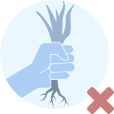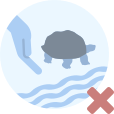
Go to our visitor centres, information points and ecomuseums to get the most out of your visit.
This Special Area of Conservation serves as a prelude to other natural protected areas of indisputable recognition in the Natura 2000 Network, such as the Sierra de las Nieves SAC and the Sierra de las Nieves Special Protection Zone for Birds (SPA). Thanks to its own natural values it gives a great impression of what is yet to be discovered in an environment of great landscapes, and ecological and environmental value. Sierra Blanquilla is a visually typical area of the Serranía de Ronda, dominated by carbonate rocks, whose greyish and whitish hues are loyal to the name by which this mountain range is popularly known.
Belonging to the Betic mountain systems and more specifically to the Subbetic Cordillera, it is a geological composition in which dolomites, limestone, flint limestone and marlstone abound. These materials suffered major faulting during the tectonic stage, especially notable in the 3 kilometre fault that “breaks” the width of the SAC in a northwest-southeast direction from Puerto de los Empedrados to almost the level of the neighbouring River Turón. Geology and geomorphology enthusiasts will be delighted to discover anticlines, discordant contacts, faults, stratification zones, karstification platforms and other elements of scientific, educational and didactic interest.
The average altitude is around 1,000 metres, with a maximum height of 1,428 metres at the Blanquilla vertex. This peak´s summit, with fascinating almost conical morphology, is located outside of the SAC, though only a few metres from the western limit of the protected area. Aside from its great heights, the landscape is a fantastic sight for visitors to the area, and one of the locations with the highest visual value within the SAC is located on the same road that connects the town of El Burgo with Ronda, specifically the stretch nestled between the limestone walls of the Arroyo de La Venta gorge near Cortijo del Boquerón; the reason it is known locally as “Hueco del Boquerón” (Hollow of Boquerón). Its cliffs are home to various birds typical of cliffs and is a kid of a mini reservoir of biodiversity.
Another of the most popular areas in this environment, namely for its ease of access, is “La Ventilla”. The name refers to an old construction of which there are still remains, the old Venta La Añoreta, which was a roadside rest stop for muleteers and travellers going from Ronda to El Burgo along the Cañada Real de Malaga livestock road. It is still used today by hikers, cyclists, runners, hunters and farmers. It is worth highlighting the water “troughs” found there; several stone basins whose icy cold waters come from the Ventilla well which has a temporary upwelling of water, but more than provides, especially in the rainy season when the water gushes from it. Within the SAC there are only small temporary streams and channels, but the geological nature of Sierra Blanquilla means that the massif functions similarly to a sponge, capable of accumulating water in large quantities. For this reason, the Hydrological Plan of the Hydrographic Demarcation of the Andalusian Mediterranean Basins catalogues a great mass of underground water, of carbonated typology, called Sierra Hidalga-Merinos-Blanquilla, and the nearby lands of a similar nature under the SAC.
In terms of the climate, on which the recharge of the aforementioned aquifer depends, the area follows general Meso-Mediterranean norms, with hot dry summers and cold winters with frost and low rainfall. The harsh thermal and hydrological conditions and the management of the territory are related to the aspect of the terrain seen today. According to the classification of land uses from the CORINE Project, about 65% of the surface of the SAC is occupied by plant formations where arboreal layers are scarce or non-existent, instead with predominating non-wooded grasslands, dense scrubland and patchy areas of scrubland. The wooded formations are relatively dense and made up of conifers, representing approximately 8% of the space, mostly reforested with Aleppo pines, although the forest with the most potential in this area is the mountain holm oak.
This wide diversity of plant communities produces a mosaic of habitats of community interest, justifying the inclusion of Sierra Blanquilla in the Natura 2000 Network. Seven of these habitats have been identified, with one of them regarded as priority, and the most important one being the endemic oro-Mediterranean heaths with gorse, producing rosemary and thyme bushes in the poorest soils, or in the dolomite areas, sections of scrub with gorse. The sub-steppe grassland habitats are equally significant, with a great diversity of species of perennial and annual plants and especially grasses (the priority habitat), and Mediterranean pine forests. The latter sometimes mixed with holm oaks when it does not reach a size large enough to constitute its own habitat, which generally only occurs in the central area of the protected space.
In terms of fauna in Sierra Blanquilla, the SAC is included in specific species´ recovery and conservation plans, as it forms part of the critical areas for the preservation of their populations. It is consequently included in the Plan for the Recovery and Conservation of Necrophagous Birds, due to the presence of Egyptian vultures, and is also a part of the Amphibian and Reptile Conservation Program, since the abundance of clearings and water areas are ideal grounds for herpetofauna. Among the species of reptiles of community interest present in Sierra Blanquilla, the horseshoe whip snake and, ocellated lizard and spiny-footed lizard are worthy of mention. Regarding amphibians, the Spanish painted frog is another species of community interest, and the salamander somewhat more widespread.
As for birdlife, despite the fact that the SAC is a migratory passage zone, it is those of the sedentary kind on which the European Union focuses, given that they are species of community interest. The golden eagle is one of the examples; reigning the skies and over the peaks. The Eurasian eagle owl, peregrine falcon, Bonelli´s eagle, Thekla´s lark, woodlark, the Dartford warbler and the red-billed chough are many other examples of species that can be spotted in the area, so bring a pair of binoculars when visiting.
Mammals of community interest include several cave-dwelling bats that, despite not sheltering actually within the SAC, are likely to enter it given the close proximity to their quarters. Also significant is the presence of species highly adapted to the steep topography on the northern strip, such as the wild goat, and ubiquitous species such as the wild boar and the fox.
Within the SAC itself, the Andalusian Hunting Reserve of the Serranía de Ronda is of great importance, as the age-old past time of big game hunting contributes economically to the area. Recreational activities and opportunities to enjoy nature are easily accessible, with the area being so close to the centre of El Burgo. The SAC is crossed over or limited (depending on the section) by the A-366 highway from Ronda to Coín, which can get very busy, especially near the popular viewpoint Mirador del Guarda Forestal. Be sure to visit the viewpoint, however, since its views are spectacular.
To add more interest yet to this impressive geographical area in El Burgo, Sierra Blanquilla has been the cradle of famous individuals, as is the case of the one detailed below. In these cold and harsh lands, in one of the humble buildings of the Puerto de Los Empedrados, (of which barely recognisable remains remain), the famous Serranía de Ronda bandit, Juan José Mingolla Gallardo, better known as “Pasos Largos” was born, on the 4th of May 1873. It was also very close to the western limit of this SAC mass, in the Sopalmillo Cave, where the bandits ended their days on the 18th of March, 1934, after a shootout with the Civil Guard, according to the official version of the event.
The SAC is internationally recognised by UNESCO, included in the Intercontinental Biosphere Reserves of the Mediterranean and the Sierra de las Nieves, demonstrating its environmental significance.




Go to our visitor centres, information points and ecomuseums to get the most out of your visit.

Follow the recommendations and comply with the regulations at all times

Respect the facilities put at your disposal. We all pay for its maintenance.

Help prevent fires. Do not throw cigarettes or any other object that produces combustion.

Trash doesn't come back alone. Take it with you to the nearest container. Reduce, reuse, recycle.

Noise is another form of pollution. In silence you will enjoy your experience more.

Live respectfully with the locals and other users. Respect private property.

Facilitate use for people with special needs.

By consuming local products and counting on local companies, you will contribute to rural development.

Practice responsible tourism and committed to the environment. Be a true ecotourist!

Never leave your pet in the wild. It would endanger the flora and fauna of the place.

Get around in a sustainable way: public transport, bicycle, on foot, electric or shared vehicle ... Park in the designated places

Do not leave a trace of your passage through nature. The best memory you can take with you is your own photograph.

Your safety is our concern, but it is your responsibility.

The conservation of natural spaces is also in your hands. Thank you for your collaboration!



